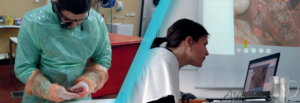Veterinary telemedicine enables veterinarians to carry out remote consultations and use digital tools to request advice. Veterinary telemedicine has been authorized for use in the US since 2017. Veterinarians can offer clients telemedicine services as long as they have established a Veterinarian-Client-Patient Relationship (VCPR), as defined in the applicable state’s veterinary practice act.
Veterinary telehealth is the overarching term that refers to all uses of technology to remotely deliver health information, education or care. It encompasses telemedicine, telemonitoring and teleconsulting.
1.Telemedicine
Telemedicine is the remote examination of an animal or animals via videoconference. This allows veterinarians to make a diagnosis and provide prescriptions where a VCPR has already been established.
For example, it is no longer necessary to take a diabetic cat to the vet on a regular basis if its medical condition does not require it. Veterinarians can also use telemedicine to assess how a wound is healing or to check on a scar.
Telemedicine helps avoid overcrowded waiting rooms, and it can also quickly reassure clients if they have any concerns. It also means that the animal does not need to travel to the clinic, thus avoiding the unnecessary stress of being in a transport crate. Obviously, if an animal requires urgent treatment, an on-site clinical examination will be necessary.
Telemedicine also makes it easier for veterinarians to ensure regular and frequent monitoring of animals located in remote areas with difficult access to medical services.
View the video about Vet’eau here. This veterinary practice provides telemedicine services for aquaculture farms using the XpertEye aR+ solution in conjunction with smart glasses.
2.Telemonitoring
Telemonitoring allows veterinarians to follow developments in an animal’s or a farm’s health status (temperature, weight variation, signs of dehydration, etc.) using connected medical devices and video solutions.
In pig farming, for example, microphones can be used to pick up sounds to distinguish between a healthy cough and a pathological cough. Thermal cameras can also be used on farms, as they provide farmers and veterinarians with important information on the condition of the animals. This makes it possible to treat incipient diseases and thus avoid expensive treatments when the disease develops.
During health crises such as Covid, bird flu or swine flu, farmers want to limit the number of external visitors to their farms to avoid any risk of contamination. In this situation, videoconferencing can be used to perform remote audits of their farms. The farmer, equipped with smart glasses or a smartphone, can connect to an auditor/veterinarian to perform a complete audit of the livestock.
3.Teleconsulting
Teleconsulting is where a veterinarian remotely seeks the advice of one or more colleagues, usually because of their specific training, specialization or expertise. For example, veterinarians may avail of video assistance during surgery, receive diagnostic assistance during an autopsy or when interpreting an X-ray, or receive assistance from a laboratory veterinarian.
Dr. Laetitia Dorso, a veterinarian specializing in pathological anatomy, uses the XpertEye solution to assist veterinarians in the diagnostic autopsies of cattle and horses. In cattle, for example, a good autopsy has multiple benefits: it establishes if there is a potential risk to other animals in the herd; it warns of a possible epidemiological risk; and it can identify a responsible third party in certain cases, potentially giving rise to a claim. XpertEye allows this specialist to remotely help her colleagues acquire specific skills in their field. 👉 Find out more (Article in French)

Smart glasses allow the expert to view in real time what the practitioner performing the remote autopsy actually sees.